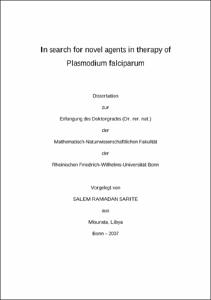Online-Ausgabe in bonndoc: https://nbn-resolving.org/urn:nbn:de:hbz:5N-14648
urn: https://nbn-resolving.org/urn:nbn:de:hbz:5N-14648,
author = {{Salem Ramadan Sarite}},
title = {In search for novel agents in therapy of Plasmodium falciparum},
school = {Rheinische Friedrich-Wilhelms-Universität Bonn},
year = 2008,
note = {
Malaria is an infectious disease transmitted by the bite of the female Anopheles mosquito. It’s the third most infectious cause of mortality, is prolific in more than 40% of the world’s population and causes more than one million deaths each year, especially in Africa, in addition of more than 300 million acute illnesses. Malaria is caused by an intracellular protozoan of the genus Plasmodium belonged to the Phylum of Apicomplexa. The four species of Plasmodium are i) Plasmodium vivax, ii) Plasmodium ovale, iii) Plasmodium malariae, and iv) Plasmodium falciparum.
P. falciparum is by far the most prevalent species and causes most problems as a result of its virulence and drug resistance. It has a rapid rate of asexual reproduction in the host and an ability to sequester in small blood vessels, with high risk for development of cerebral malaria. Over the last few years the situation has become even more complex because malaria parasites have been developing unacceptable levels of resistance to one drug after another. Hence, the increasing resistance of the malaria parasite has enforced new strategies of finding new drug targets.
The eukaryotic translation initiation factor 5A is an intriguing protein, because it is the only cellular protein known to contain the unique amino acid hypusine, a modification that appears to be required for cell proliferation. The eukaryotic translation initiation factor 5A and its activating enzymes are novel targets in HIV (AIDS) and cancer therapy. In principle two different strategies of inhibition of the eukaryotic translation initiation factor 5A formation exist: One strategy is inhibition of the eukaryotic translation initiation factor 5A modification by means of the deoxyhypusine synthase protein and a second one focuses on the deoxyhypusine hydroxylase inhibition.
Natural and synthetic phenazines have attracted considerable attention because of their interesting biological activities, including broad-spectrum antibiotic, anti-malarial, trypanocidal along with anti hepatitis C viral replication activities.
Phenazines have also been described as dual inhibitors of topoisomerase enzymes class Ι and ΙΙ. In addition to that, phenazines can play an important role as antioxidants by interfering with the oxidative burst.
This study was aimed to investigate the in vitro anti-malarial affectivity of the deoxyhypusine synthase inhibitor, the deoxyhypusine hydroxylase inhibitors, the polyamintransport inhibitors, the phenazines analogues and the dihydroartemisinin analogues. And to confirm in vivo the results obtained in vitro.
The Plasmodium culture systems have been extensively used for screening new drugs, to study the mode of entry of parasite into erythrocytes, to isolate and characterize strains and clones, and to identify immunogenic and genome of parasite. However, in this study the microscopic screening method has been chosen to test the in vitro and in vivo antimalarial activity for several kinds of inhibitors.
Among the compounds studied in here, nineteen new compounds exhibited in vitro anti-malarial properties, due to different mode of action.
Plasmodium berghei ANKA was used in this study to confirm in vivo the obtained in vitro results. Plasmodium berghei ANKA murine malaria has many features in common with the human disease and is thus an accepted model for certain important aspects of clinical malaria.
In conclusion, inhibiting the deoxyhypusine synthase seems to have more efficiency than inhibiting the deoxyhypusine hydroxylase in inhibiting the proliferation of the Plasmodium berghei ANKA. Inhibition of polyamine synthesis in vitro showed a promising approach to the identification of anti-protozoan drugs with chemotherapeutic potential.
Some phenazines exhibited anti-proinflammatory property, as they were able to interact with the circulated tumour necrosis factor and lymphotoxine alpha, and reduce the plasma levels of these proinflammatory cytokines. The high plasma tumour necrosis factor levels cannot be the only element responsible for the symptoms unique to cerebral Plasmodium berghei ANKA malaria.
url = {https://hdl.handle.net/20.500.11811/3637}
}






